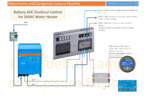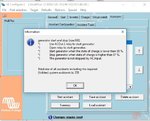Now the following diagram hopefully shows what the plan is for my future reconfiguration.
The products shown are not a requirement (so you can substitute the
Multiplus for a basic
inverter and a 240V 'Contactor' for example) but represent one way on what you are talking about could be achieved in a factory-built motorhome, using some of the existing installation (e.g. a Sargent Power unit) with minimal reconfiguration.
Caveat: In this case we are talking about some 240V rewiring, so great care and caution must be applied and any doubts, get someone suitable in to do/check the work!
Preamble.
The typical Sargent unit has 3 AC outlets, one for General use, one for (space) Heater, and one for Boiler, Fridge and Built-in Charger.
Being able to use General AC sockets when off-grid for stuff like Laptop charging or similar can be very handy.
A Space Heater will draw so much power on electric, it is not feasible (on a cost basis) to run that on batteries.
A typical Motorhome Boiler is only around 10L and if the electric installation is sized sufficiently (
battery and
solar), it is perfectly possible to run that on Batteries
within reason. The same may be true of a 3-Way fridge (depends on fridge however).
The following diagram shows how a
Victron Multiplus Inverter/Charger could be added to a typical British Motorhome setup.

The feed into the Sargent RCD will be changed from EHU direct to go instead through the
Multiplus AC-1 outlet
The first MCB (light blue) is not adapted and so is fed from the RCD and its output will be active, either on mains or
inverter
The second MCB (dark blue) is typically designated for a Heater, and the input of that will be changed to being fed by AC-2 from the
Multiplus
The third MCB (Violet) is designated by Sargent for the Fridge, Boiler and Charger. Here the input will still be fed from the RDC, but via a 240V SSR Relay, controlled by an SOC (State of Charge) monitor. I show this controlled by the relay within the
Victron BMV-712, but if you have a
Victron GX unit (e.g. a CCGX, Venus GX, etc) for example, you could use the relay within those (shown by the dotted line).
The Relay would be setup so it only goes on when the
battery is at a state of charge you decide. The best value will depend on your own setup, but probably somewhere over 90% might work best for most?
The Relay in the
BMV-712 and GX's can be manually turned on as well so if you are driving for example, or if it is a nice day forecast, you could decide to enable it to save on gas even if the
battery is below the SOC you set, knowing you will make it up later anyway from the B2B or
solar.
Ref AC-1 and AC-2 mentioned ... The Larger Multipluses have two AC outlets - AC-1 is the outlet that will be driven by Mains when plugged in, or
Inverter when off-grid; AC-2 is a specific Mains-only outlet, so if unplugged from EHU will be off. This is ideal for something like a space heater.
The benefit of using the AC-2 outlet rather than bypassing the
Multiplus is that you can set a maximum current (for if you are on a campsite with limited current supply) and both AC-1 and AC-2 are monitored to make sure you don't exceed that and overload/trip the external campsite breaker.
There is a limitation to the setup above however - if for example you arrive at a site and plug in to EHU, but your batteries are below the required SOC, the supply to the Boiler and Fridge will remain off. You would need to remember to go into the
BMV settings and manually turn the relay on. This I think will be a minor annoyance, but if you wanted to avoid even that manual interaction, you can do so by adding a auto-switching 240V relay that detects the presence of mains and switches to it automatically. I am in two minds whether to do that or not (the cost to add that feature would be around £20 and minimal extra wiring, so not a problem there, however you would lose out on accessing a potentially handy feature of the
Multiplus called Power Assist which could be very useful on those limited EHU campsites)
Finally, this wiring also means the charger built into the Sargent could actually run off the batteries to then charge those same batteries! I would not use that charger anyway so it does not matter but if you wanted to it would be necessary to make some further adjustments.


